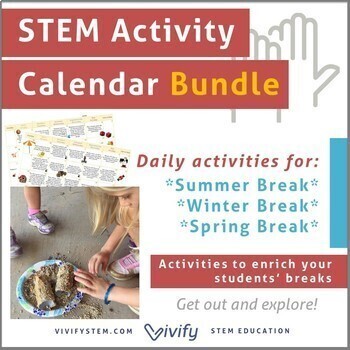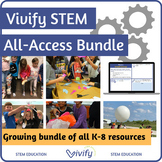Year-Round STEM Activity Calendar Bundle
- Zip
Products in this Bundle (4)
Bonus
Also included in
- Are you in need of year-round STEM activities? This growing bundle includes ALL Vivify K-12 STEM lessons from team challenges, engineering design, semester-long STEM units, research projects, and more! Purchase everything for 20% off individual products! Here is a sample of what is included: Stage 1Price $990.24Original Price $1237.80Save $247.56
Description
Keep students engaged all year long with this bundle of STEM activities for every school break or during school closings! This bundle includes 22 weeks of unique daily STEM activities that can be completed at home. Perfect for summer holidays, spring break, or winter break to keep students learning. Spanish version included for the editable 6-week activity chart!
Each STEM calendar includes daily science, engineering, and math challenges for school breaks! Activities are straightforward and accessible to students of all levels with little or no supplies needed. Get them up, outside, and exploring the world! Students will build a bird feeder, make a lava lamp, cook with fractions, and so much more! The world outside is their new and exciting classroom.
The daily activities will incorporate math concepts, scientific thinking, critical thinking, communication, creativity, and real-world problem-solving. Recommended for upper elementary and middle school grades with a wide range of skill levels.
STEM = Science, Technology, Engineering, Math
Math Monday
Students apply math concepts to real-world scenarios. Examples: Budget for a shopping trip, measure your heartbeat, cooking using fractions.
Outdoor Tuesday
Students get outside and explore nature! Examples: Build a bird feeder, plant a flower, go bird watching.
Science Wednesday
Students explore scientific concepts with hands-on experiments and observations with common items. Examples: Make a lava lamp, design a baking soda/vinegar experiment, discover tongue theory.
Engineering Thursday
Students will explore engineering through design and building activities using household items. Examples: Design a catapult, build a water balloon helmet, invent a new alarm system
Fun Friday
Students get a mix of science, engineering, and math activities with the goal to have some fun. Examples: Create an obstacle course, make symmetry art, design a senses challenge.
Looking for more STEM lessons? Our team of engineers and educators is dedicated to developing low-prep and high-quality STEM activities for any classroom! Click below to learn more:
- Vivify's Scope & Sequence + Standards Alignment
- Vivify's Resource Guide
- Learn about the 3 Stages of STEM
- Vivify STEM Membership
Customer Tips:
• Click the Green ★ to follow our store and get notifications of new products and freebies
• Leave feedback to receive TpT credit for use on future purchases
• Questions? Contact us in the Product Q&A section
♥ Connect With Us ♥
Email us: info@vivifystem.com






